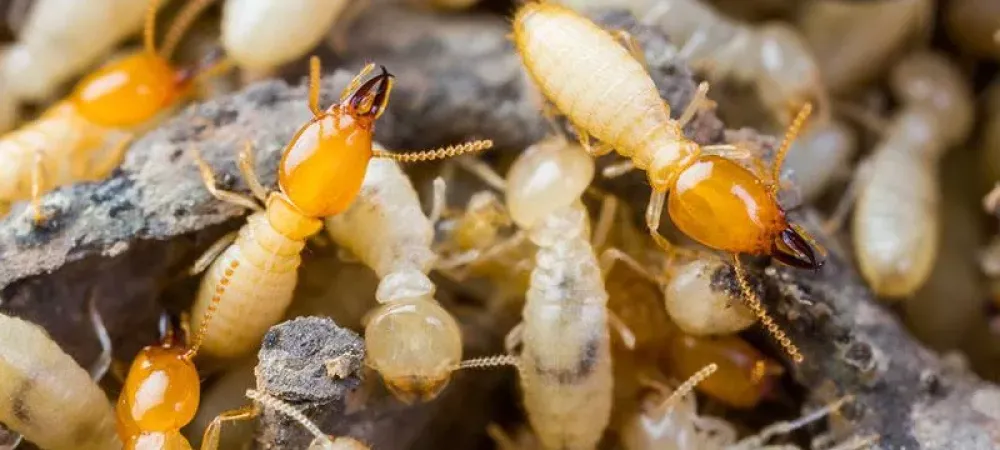A Guide to Termites in South Carolina

No one wants to hear that their home has been infested with termites. These wood-destroying pests cost US residents over 5 billion dollars in damage and repairs every year. They have a ferocious appetite for wood and will stop at nothing to find it. The most effective way to prevent your property from being inhabited by these voracious insects is by knowing how to identify them and understand their behavior. Read on and find out everything you need to know in our guide to termites in South Carolina and how Beach Pest Service can help.
How to Tell if You Have Termites
Termites can be hard to detect since they dwell inside the walls and wooden structures of your home. And although termites are noisy when feasting, the sounds are often too faint for humans to hear without specialized equipment. Fortunately, there are other signs you have South Carolina termites, including:
- Mud tubes on the ground, which are small tunnels used to protect termite nests.
- Hollow-sounding wood, since termites feast on wood from the inside!
- Seeing termite swarmers leave their colonies to find a new one.
- Pale-colored wings discarded around your home.
- Squeaky floors might be just a sign of an old home, but it could be an indication of a termite problem.
What do Termites Look Like?
While there are different species of termites, generally, they are soft-bodied creatures that vary in translucent shades of white, brown, and black. They are often confused with flying ants because both have wings and an antenna.
How Big are Termites?
As destructive as they are, termites are very small. Depending on the termite, they range in size from ¼ to ⅜ of an inch long.
Where do Termites Come From?
Surprisingly, termites do not start as residents of our homes. Most termite species come from the ground. Subterranean termites live in the soil but are often drawn to our homes for water leaks and high humidity due to their need for moisture to survive. They build mud tubes from their place of origin finding cracks and holes in your foundation to get in.
Drywood termites come from places where dry wood exists, like forests and trees in your backyard. If they make their way into your home, it's because they have found access through wooden furniture or firewood.
Termite Swarming Season
Sounds creepy, doesn’t it? But termite swarming season is a natural progression of a termite's life. Hundreds of termites are produced with the sole purpose of reproducing. Once a year, when the weather conditions are right, and a colony has reached its peak size, termites with wings will leave their home, launch into the air, and pair off. Couples will then shed their wings and find a new place to populate. Regardless of the type of species, most swarming takes place following a rain storm and when the winds are under 6 mph.
Types of Termites in South Carolina
Here in South Carolina, with our warm and humid climate, termites are quite common. We have several different species of termites including subterranean, Formosan, and drywood.
Subterranean Termites
The most common type of termite in South Carolina is the subterranean termite. These pests live and build their colonies underground and inside dead trees. They prefer dark, damp areas because they rely on moisture to keep them alive. They construct mud tubes as a way to travel and remain protected. They are typically translucent gray to brown with long heads and long pinchers.
Formosan Termites
A type of subterranean termite, these critters live in the soil. They enter the home directly from the soil or by using mud tubes they construct from the ground. While subterranean termites are found in all 50 states, Formosan prefer the warmer climates of our southern states. They are translucent orange with longer bodies, shorter heads, and two pinchers.
Drywood Termites
Called such because they build their nests within drywood, these particular termites do not need moisture to survive. Like Formosan termites, the drywood prefers environments where the winters are mild. They often enter homes through exposed wood or infested furniture. They do not have a preference for soft or hardwood, continually gnawing through an entire structure and destroying it until it completely collapses. The same size as the other two species, drywood termites have a thicker waist and are cream to white colored.
Got Termites? Call the Professionals!
If you are experiencing any of the symptoms above or believe you may have an invasion of termites, you will want to call a professional exterminator immediately. The sooner you find and eradicate them, the less damage you will encounter. The skilled experts at Beach Pest Service can help. Learn more about our termite control services, and contact us today! We service Myrtle Beach, Conway, and surrounding areas.
Frequently Asked Questions
What do Baby Termites Look Like?
Baby termites start as white/yellow eggs protected inside a nest. From there, the egg hatches into what appears to be a miniature termite. If you didn’t know any better, you might think these little pests were ants. It’s pretty rare, however, that you will catch a glimpse of a baby termite as they are typically protected from view by the worker termites.
How Long do Termites Live?
The life cycle of a termite is quite interesting. Unlike most insects that go from egg to larvae to pupa to adult life, termites start off as eggs known as nymphs and then hatch right into miniature-looking termites. Extremely social creatures, termites each play a role in their society. Worker and soldier termites live approximately one to two years, while queen termites, the leaders, and reproducers of the colony, can survive for decades.
What do Termite Eggs Look Like?
Termite eggs look almost like small jelly beans. Of course, these are not the kind of jelly beans you want to eat. They are also tiny and oval-shaped with a shiny, translucent exterior. Most are white, yellow, or brown in color.
